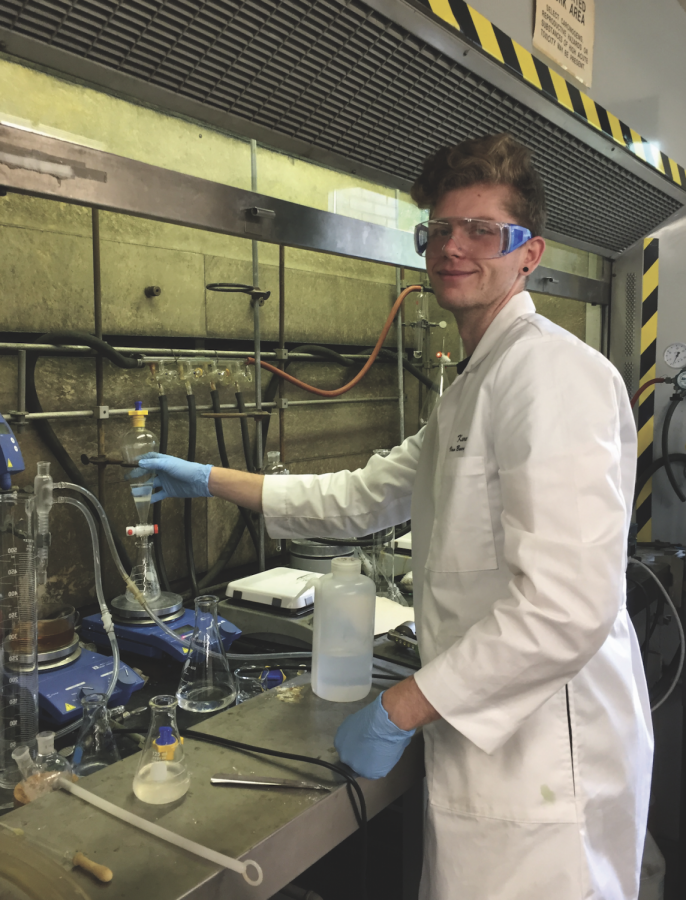Fordham Student Researchers Share Their Summer Experience
Four Fordham College at Lincoln Center students researched topics spanning from paleoecology to genetic neuroscience
Karel Van Bourgondien, FCLC ’21, working on an anti-Hepatitis C agent in a chemistry lab in John Mulcahy Hall at Rose Hill.
August 25, 2019
Anusha Imran, FCLC ’22
Anusha Imran, FCLC ’22, spent her summer sifting through prehistoric mud from the Hyde Park excavation site. Under the supervision of her mentor, Guy Robinson, Ph.D., she collaborated with a group of students to find possible hair samples of mastodons — large mammals that went extinct during the Pleistocene epoch. Their closest living relatives in the animal kingdom are elephants.
There is a consensus among the scientific community that mastodons were covered entirely in hair because of the climate in which they lived. Imran says they were able to find potential hair samples of these late creatures. However, there is no evidence yet to confirm this hypothesis.
Imran believes the most important part of their research was the evidence they found regarding the climate change that occurred in that era.
Imran and her fellow researchers had two components to their research. The first part was to extract samples from the utmost top layers of the sediment specimen that date between 11,230 to 12,120 years ago. With these samples, they collected many vials of spruce and needles. This indicates that these large mammals lived in warmer climates.
The second part of this study was to stratigraphically analyze samples from 12,480 to 12,880 years ago. They were able to find Dryus plant remains, which suggests these samples are from a tundra-zone. This can tell us that climate change in their habitat is one reason mastodons went extinct.
Karel Van Buorgondien, FCLC ’21
Martin Di Grandi, Ph.D., and Karel Van Buorgondien, FCLC ’21, set out to find the most efficient route in synthesizing an anti-Hepatitis C compound. They focused on a model compound that was akin to the one they desired to create. The biggest obstacle they faced was trying to effectively complete all of their reaction steps. At times, they did not find a high enough yield on part of their experiment, which impacted the initiation of the next steps. Van Buorgondien further explained that the compounds they created were sometimes slightly off from the structure they were looking for.
Despite these challenges, Van Buorgondien believes that the proper production of this compound will allow them to pharmacologically create a form of treatment that can be prescribed in conjunction with some HIV medications. He emphasized the comorbidity of HIV and Hepatitis C and believes this compound administered in conjunction with other HIV medications will increase prevention and decrease the prevalence of Hepatitis C. He is optimistic about this study streamlining the process of making these drugs.
Royal McMahon Ward,
FCLC ’22
Royal McMahon Ward, FCLC ’22, teamed up with Mark Botton, Ph.D., this summer to study the degree to which flatworms infest adult and juvenile American horseshoe crabs in Jamaica Bay. One component of her research was to compare the severity of infestation among horseshoe crabs of different sexes, conditions and prosoma widths.
Ward observed flatworms in every fully developed horseshoe crab but did not find any in the juvenile horseshoe crabs. After analyzing her subjects further, she found that female horseshoe crabs had a higher rate of infestation than males. She also found a correlation between the condition and prosoma width of horseshoe crabs and the scale of their infestation. When she combined the data for female and male horseshoe crabs, she found the presence of flatworms was more significant in larger horseshoe crabs.
Ward believes that her data will establish the foundation for further research into how flatworms enter horseshoe crabs. She aspires to continue her research in order to develop a methodology to quantify the rate of flatworm infestation in horseshoe crabs.
Jessica Caushi, FCLC ’21
In our brains, we have excitatory and inhibitory neurons. Excitatory neurons help generate action potentials that let us respond to external stimuli. When the brain is in a constant state of excitation, it can lead to a variety of neurophysiological disorders. The KCC2 gene is responsible for the production of inhibitory neurons that help the brain circumvent the exhaustion that a prolonged excitatory state would produce. This summer, Jessica Caushi, FCLC ’21, strived to locate the KCC2 gene before and after it is turned on in order to create an epigenetic map of the gene in zebrafish.
Caushi believes that this map is crucial to understand the role of this gene in the regulation of neurons. By using the zebrafish as a model of how the gene functions, she will later be able to understand how this gene operates in humans.
She is optimistic that this epigenetic map will help future studies concerning neurophysiological disorders associated with an imbalance of excitatory and inhibitory neurons, such as autism and epilepsy.










